As a practitioner, you know foot pain should be addressed as soon as possible, as pain in one or both feet can potentially lead to impairment of foot function. But rather than treating foot pain with over-the-counter pain and anti-inflammatory medications such as ibuprofen, or prescription nonsteroidal anti-inflammatory drugs (NSAIDs), or even corticosteroid injections for chronic foot pain, why not try red light / infrared therapy?
Shoulder Strategies: Reduce Pain, Improve Function With Proper Taping
Editor's note: This is the second article in a series on functional taping in the chiropractic setting.
Shoulder pain / dysfunction is a common problem for chiropractic patients. Clinicians who utilize elastic therapeutic taping as part of their treatment approach know it can be effective for a variety of shoulder problems. Compared to other types of tape, the tape is very thin and flexible, allowing the shoulder to move through its full range of motion.
It is thought that the immediate pain-relief effect many patients feel with elastic therapeutic tape comes from a pain-gate effect, as the sensory receptors in the skin and fascia are stimulated by the lifting and shearing effect created by the tape. Movement changes most likely come from normalization of efferent motor control as a result of stimulation to these same sensory receptors.
Why It Works
A study of 18-24-year-olds enrolled at the United States Military Academy showed elastic therapeutic taping was effective for improving pain-free range of motion in young people with shoulder pain.1 Another study showed tape and home exercises for shoulder impingement syndrome was more effective in the first week, and equally as effective in the second week, as daily use of physical therapy modalities. The control group utilized the same home exercise program with daily ultrasound, TENS and hot packs.2 Findings suggest a much more convenient and time-saving approach for both the patient and the clinic, in addition to helping the patient feel better and improve faster.

In another study of baseball players with shoulder impingement syndrome, elastic therapeutic taping was found to improve scapular motion and muscle performance. The authors concluded that taping was supported "as a treatment aid in managing shoulder impingement problems."3
Another interesting case report in the literature described using elastic therapeutic tape and exercise for a 2-year-old patient with a neonatal brachial plexus injury. She exhibited severely impaired muscle function, and demonstrated severe subluxation of the humeral head and scapular winging. After 20 weeks of treatment (12 total visits), the child had full range of motion, structural shoulder symmetry, and was negative on all of the initial examination findings. She was even hanging by her arms in normal play activities. Her reconstructive surgery was cancelled.4
As with other areas of the body, there are many approaches to using elastic therapeutic tape on the shoulder. The most basic approach shown in this article uses three strips of 2-inch-wide tape. Tape is available in other widths, too, so the application can be matched to the patient's size and needs.
For most shoulder applications, the patient should be instructed to keep the tape on for 3-5 days, and it is assumed that the clinician also instructs the patient on proper maintenance and removal of the tape, rules out the potential for adverse reaction, and properly examines and diagnoses the problem.
Applying the Tape
Begin by measuring three strips of tape. The first strip will extend from the upper trapezius area and cervicothoracic junction around the front of the shoulder and deltoid to about the middle of the upper arm. The second strip will go around the posterior shoulder and deltoid area from the middle of the upper arm to the top of the upper trapezius region and will likely be a couple of inches shorter than the first strip described. A third strip of tape, shown in the photos in red, will be stretched in the middle and applied over the most painful part of the shoulder (often the acromioclavicular joint, as shown in the photos, but of course, this will vary depending on the patient's presentation).
Round the corners from all three strips of tape so they are less likely to catch on the patient's clothing. The skin of the axillary area and medial arm is quite sensitive to tape, so be careful to apply it in a way that avoids these areas.
In order to not limit the patient's range of motion, apply the first two strips of tape with "paper-off tension" (the manufacturing process imparts approximately 15-20 percent stretch to the tape as it is applied to the paper backing), while placing the patient in a position that lengthens the tissues being taped. It is important to note that the direction the tape is applied likely has no effect on the outcome of the taping application, so feel free to tape in a distal-to-proximal direction or vice-versa.
In the example illustrated here, the patient's arm is internally rotated and placed behind their back to stretch the front of the shoulder. The first strip of tape is applied from the C/T junction area and upper trapezius around the front of the shoulder and deltoid muscle to the middle of the arm. Rub each strip of tape to ensure it adheres fully to the skin. The second strip is applied in a similar fashion around the posterior shoulder structures. The patient is placed with the arm crossing the midline to stretch the back of their shoulder.
The third strip of tape, called a decompression strip, is applied differently from the first two. Break the paper backing in the middle of the tape strip and peel the paper back to expose the middle area of tape, as if it is a giant Band-Aid. Stretch this strip approximately 25-50 percent in the exposed middle area and apply the center of it directly over wherever the patient is experiencing the most pain in their shoulder. Finish the ends of the tape with just the paper-off tension or it will be uncomfortable and will likely roll off quickly.
Possible variations of this basic taping application include lengthening the strips to extend them into the scapular area to encourage more scapular stability; or using three decompression strips focused over the area of greatest pain, as in the case of an A-C joint injury, where point tenderness would be expected.
References
- Thelen MD, et al. The clinical efficacy of kinesio tape for shoulder pain: a randomized, double-blinded, clinical trial. J Ortho & Sports Phys Ther, 2008;38(7):389-395.
- Kaya E, et al. Kinesio taping compared to physical therapy modalities for the treatment of shoulder impingement syndrome. Clin Rheumatol, 2011;30:201-207.
- Hsu YH, et al. The effects of taping on scapular kinematics and muscle performance in baseball players with shoulder impingement syndrome. J Electromyo & Kinesiol, 2009;19:1092-1099.
- Walsh SF. Treatment of a brachial plexus injury using kinesiotape and exercise. Physiother Theory & Practice, 2010;26(7):490-496.



